#Common Jewelweed
Explore tagged Tumblr posts
Text


Impatiens capensis / Common Jewelweed at the Sarah P. Duke Gardens at Duke University in Durham, NC
#Impatiens capensis#Impatiens#Balsaminaceae#Common Jewelweed#Orange Jewelweed#Spotted Jewelweed#Jewelweed#Spotted touch-me-not#Touch-me-not#touch me not#Orange balsam#Native plants#Native flowers#Plants#Flowers#Nature photography#photography#photographers on tumblr#Sarah P. Duke Gardens#Duke Gardens#Duke University#Durham#Durham NC#North Carolina#🌺🌻
14 notes
·
View notes
Photo

Common Jewelweed Impatiens capensis Balsaminaceae
Photograph taken on August 12, 2022, along the Culham Trail, Mississauga, Ontario, Canada.
#wildflowers of southern ontario#Common Jewelweed#orange#jewelweed#spotted touch me not#touch me not#Impatiens capensis#Impatiens#Balsaminaceae#wildflowers#wildflower#flowers#flora#Culham Trail#Mississauga#Ontario#Canada
36 notes
·
View notes
Text






#common jewelweed#touch-me-not#orange balsam#impatiens capensis#wildflowers#new york native plants#pelham bay park#bronx
1 note
·
View note
Text
Impatiens capensis / Orange Jewelweed




orange and yellow
#Impatiens capensis#Impatiens#Orange Jewelweed#Common Jewelweed#Jewelweed#Spotted touch-me-not#Touch-me-not#Orange balsam#Balsaminaceae#Flowers#Wildflowers#Plants#plantblr#plant identification#taxonomy
22 notes
·
View notes
Text
Wildflower Walk ?
Hello everyone! I hope this post finds you all well. I apologize for not posting for a while. It has been a weird summer for sure with the heat and drought. I was busy with the garden picking sweet corn and green beans right up until August 17. Somehow I managed to get 455 ears of sweet corn in the freezer, and thanks to the ‘Provider’ green beans, 34 quarts of green beans. Of course, not all the…
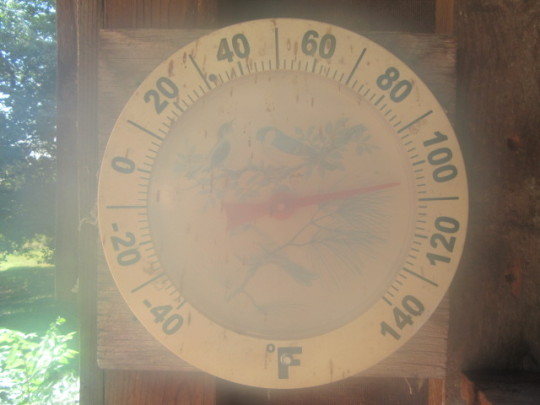
View On WordPress
#Ambrosia bidentata (Lanceleaf Ragweed)#Asclepias hirtella (Prairie/Tall Green Milkweed)#Asclepias syriaca (Common Milkweed)#Bidens aristosa (Tickseed Sunflower or Bearded Beggarticks)#Datura stramonium (Jimson Weed)#Elephantopus carolinianus (Leafy Elephant&039;s Foot)#Erechtites hieraciifolius (Fireweed/Pilewort)#Erigeron annuus (Annual or Daisy Fleabane)#Etc.)#Eupatorium serotinum (Late Boneset)#Impatiens capensis (Jewelweed)#Lespedeza cuneata (Chinese Bushclover)#Persicaria hydropiper (Water Pepper)#Persicaria pensylvanica (Pinkweed)#Phytolacca americana (American Pokeweed)#roton capitatus (Hogwort/Woolly Croton/Goatweed)#Rudbeckia hirta (Black-Eyed Susan)#Sida spinosa (Prickly Fanpetals)#Solanum sarrachoides (Hairy Nightshade)#Solidago sp. (Goldenrod)#Symphyotrichum lateriflorum (Calico Aster)#Tridens flavus (Purpletop#Tripsacum dactyloides (Eastern Gamagrass)#Verbesina virginica (White Crownbeard/Frostweed)#Vernonia missurica (Missouri Ironweed)
0 notes
Text
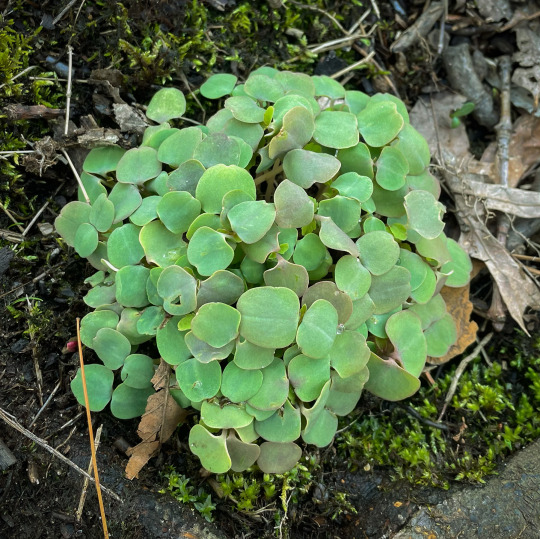
y’all know what this is?!
it is a clump of jewelweed seedlings!
common jewelweed (impatiens capensis) is native to north america and likes to grow along waterways. in the summertime she grows lovely little orange flowers.
but my favorite thing about her is her sap! it’s great for topical use on irritated skin. i make salves out of it and other happy-skin plants every summer. AND anD if you apply the sap to an area of skin that’s been exposed to poison ivy, it can prevent the rash from developing.
OMG there’s a poison ivy preventative!? well. . . no. this is a more of a “i am in the middle of the woods and have no soap and water but i DO have this plant” situation.
the thing is, you have to have to apply the jewelweed sap almost immediately after exposure to urushiol (the itchy juice in poison ivy), and if you’ve been in contact with poison ivy for more than a few minutes – which most people are because they don’t recognize/notice it – then it’s DEF not going to work. urushiol is absorbed by the skin too fast.
it’s still a cool plant and it DOES reduce itchiness and irritation from dermatitis and bug bites. 🦟
#plants#plant identification#jewelweed#impatiens capensis#us native plants#plant facts#cool plants#medicinal plants#wildcraft#my photos
58 notes
·
View notes
Text
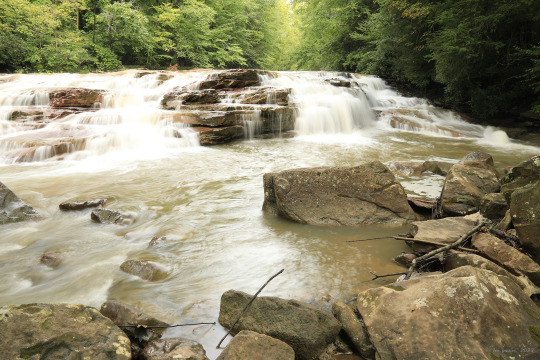
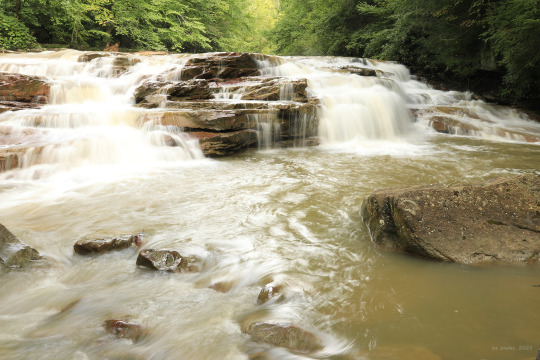
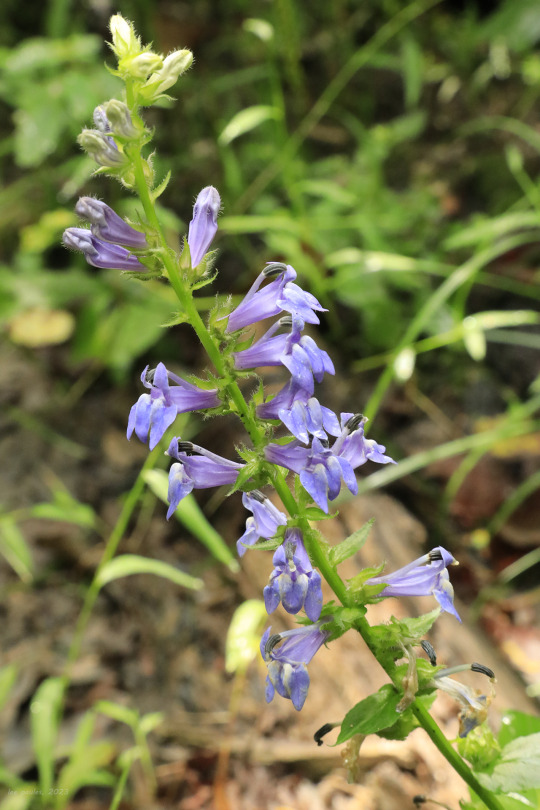

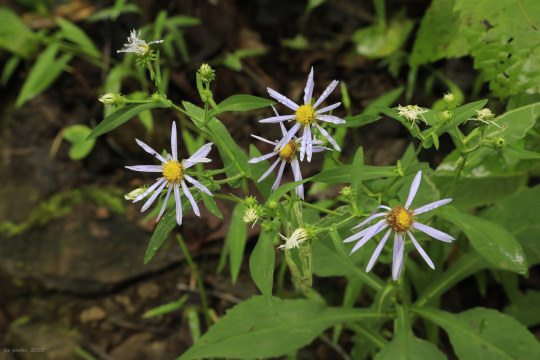
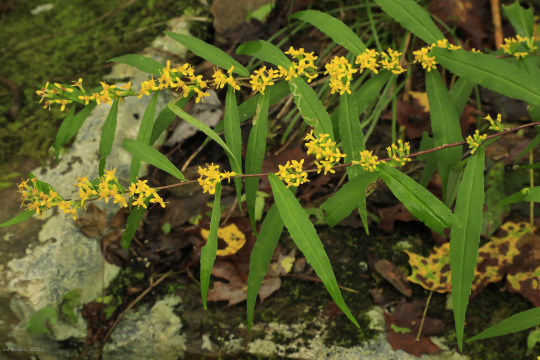
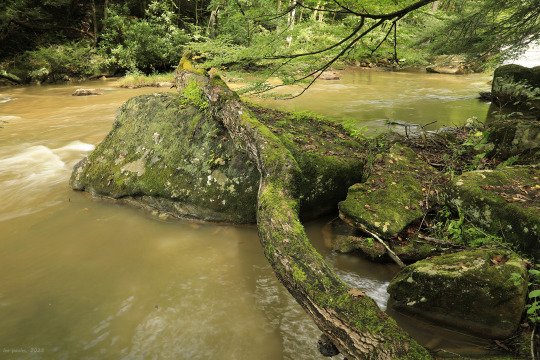
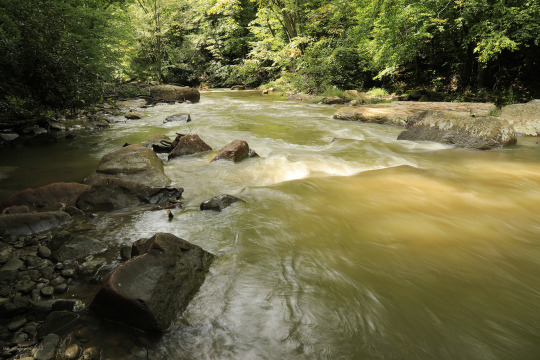
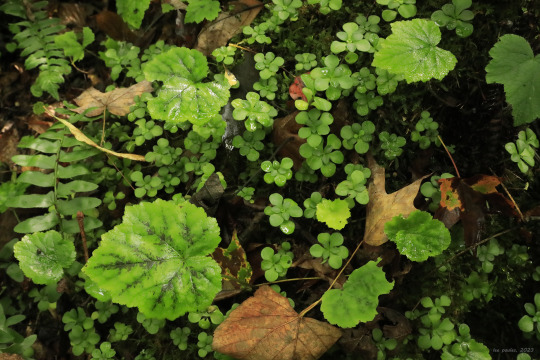
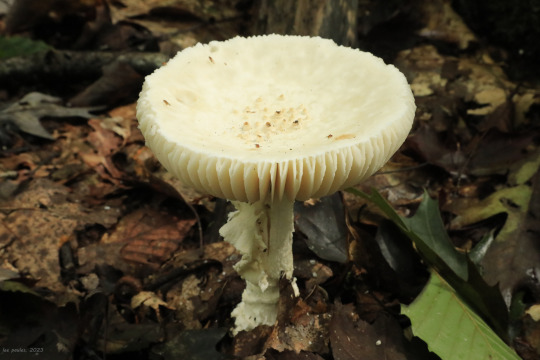
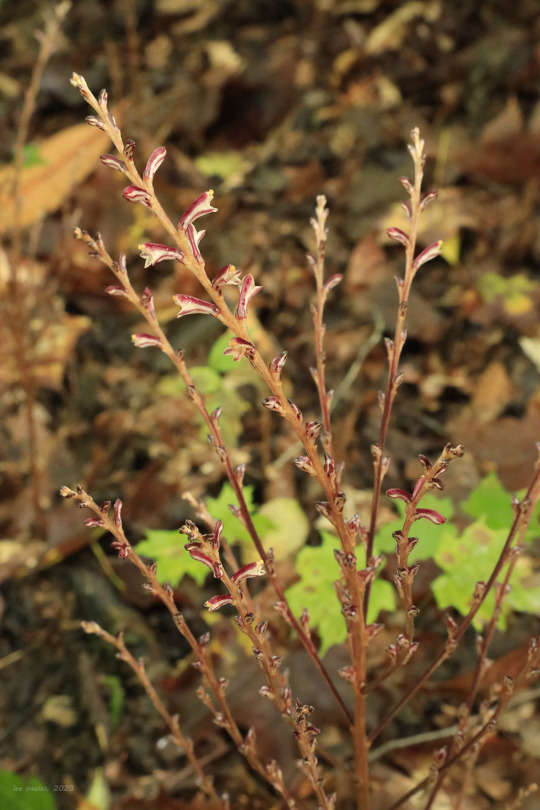
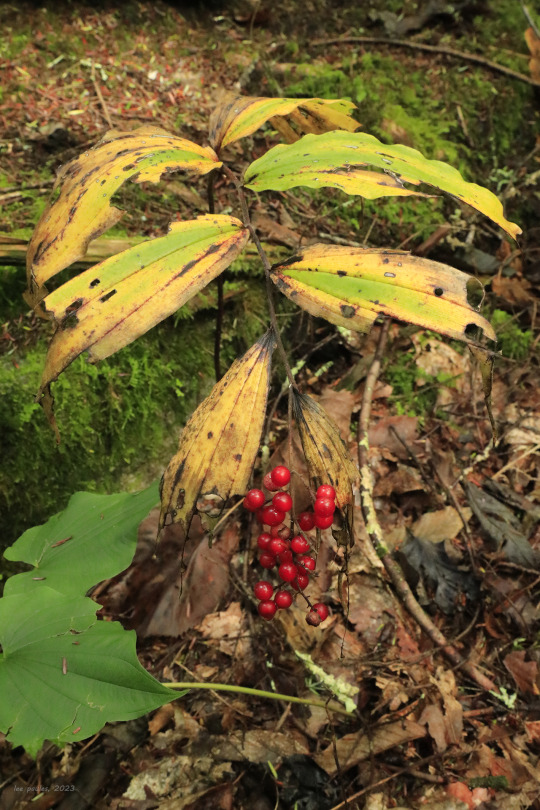
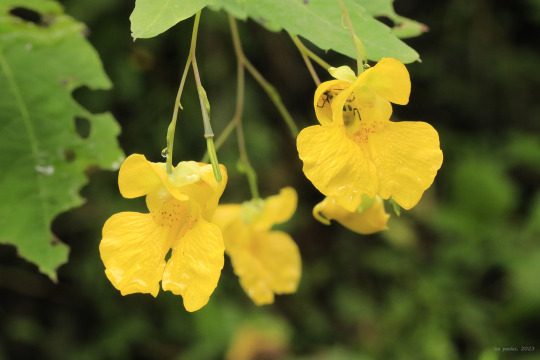
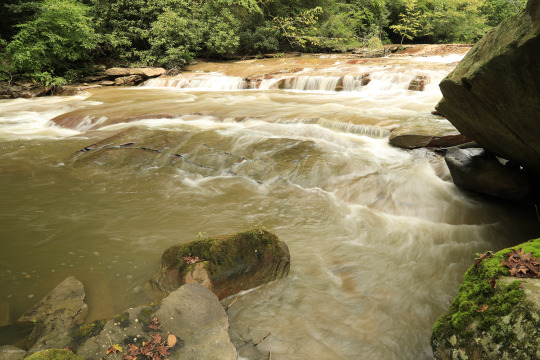

Despite its undignified name, Muddy Creek is a lovely mountain stream that normally runs fast and clear on its steep descent to Cheat River. But after a week of heavy rain in NC-WV, the stream looked a bit murky yesterday. Not even the sediment washing away from the mountains dims its beauty in my eyes. And the enchanting, moss-encrusted forest along its bank holds its own late summer treasures.
From top: great blue lobelia (Lobelia siphilitica), which pairs beautifully with cardinal flower to provide late summer color in a native wildflower garden; white wood aster (Eurybia divaricata), which is the most common of the shade-loving white asters in this area; crooked-stemmed aster (Symphyotrichum prenanthoides), also known as zigzag aster, whose clasping, spatula-shaped leaves distinguish it from big-leaf aster, another woods-loving aster with lavender flowers; blue-stemmed goldenrod (Solidago caesia), whose spreading, yellow-flowered stems provide stunning late-season color in a native wildflower garden; an intensely-green collage of moss, woodland stonecrop (Sedum ternatum), Christmas fern (Polystichum acrostichoides) and heartleaf foamflower (Tiarella cordifolia), which I am trying hard to reproduce in my own native wildflower shade garden; the shaggy-maned stem of Coker's Amanita (Amanita cokeri), one of the most impressive mushrooms of Appalachia's summer forests; beech-drops (Epifagus virginiana), a parasitic plant that grows and subsists on beach tree roots; the bright red berries of false Solomon's seal (Maianthemum racemosum); yellow jewelweed (Impatiens pallida), whose explosive seed pods give the plant its other common name, pale touch-me-not; and narrow-leaved tick-trefoil (Desmodium paniculatum), also known as panicled tick-trefoil, a late summer pea whose sticky seed pods commonly hitch rides on shoes and boots.
#appalachia#vandalia#west virginia#wildflowers#flora#summer#muddy creek#cheat river#preston county#fungi#coker's amanita#great blue lobelia#white wood aster#crooked-stemmed aster#zigzag aster#blue stemmed goldenrod#woodland stonecrop#christmas fern#heartleaf foamflower#beech-drops#beech drops#false solomon's seal#solomon's plume#yellow jewelweed#pale touch-me-not#narrow-leaved tick-trefoil#panicled tick-trefoil#falls#rapids#mountain stream
103 notes
·
View notes
Text
My Garden Flowers Part 8
All photos mine.


















In order of appearance:
211. White Avens (Geum canadense) This was here before I got there and as she's native she survived the purge I did of the weeds.
212. Orange Coneflower (Rudbeckia fulgida) I didn't plant this, but she's in lots of places now and she's not always this orange, often leaning more toward amber, but she is always very pretty.
213. Tall White Lettuce (Prenanthes altissima) Not pictured as she hasn't flowered yet.
214. American Red Raspberry (Rubus strigosus) Not pictured as she hasn't flowered yet.
215. Canada mayflower (Maianthemum canadense) Not pictured as she hasn't flowered yet.
216. Barren Strawberry (Waldsteinia fragarioides) The leaves look a lot like strawberry leaves, the flowers look like if strawberry flowers were yellow, and they make a red berry! But it tastes woody and bland. Hence the name. I still want to make a jam of them if I ever get enough of them, though.
217. Tufted Hairgrass (Deschampsia ceaspitosa) Don't mind the bull thistle behind it that I wasn't able to remove, but the foliage of the grass is a nice blue-green and the flowers are, well, tufts.
218. Largeflower Bellwort (Uvularia grandiflora) The flowers are always bowed as if wilting. They're springtime flowers only.
219. Spotted Jewelweed (Impatiens capensis) One of the only two Impatiens species native this far north. The flowers of this one are orange. She likes moist to wet spots and can handle full sun to full shade.
220. Fringed Loosestrife (Lysimachia ciliata) Yellow flowers in summer, dark red leaves in autumn.
221. Thicket Creeper (Parthenocissus vitacea) Not pictured as she hasn't flowered yet.
222. Skunk Cabbage (Symplocarpus foetidus) Not pictured as she hasn't flowered yet.
223. Black Cherry (Prunus nigra) Not pictured as I haven't got pictures yet.
224. Woodland Sunflower (Helianthus divaricata) A sunflower that can handle shade! Not heavy shade, but a considerable amount.
225. Fringed Willowherb (Epilobium ciliatum) I didn't plant this, but she has cute tiny flowers and she has tasty leaves.
226. Starry False Solomon's Seal (Maianthemum stellatum) Little star-shaped white flowers become candy-striped red berries.
227. Narrow-Leaved Wild Leek (Allium burdickii) Like her close cousin, A. tricoccum, she only matures enough to flower after seven years, so this is special.
228. Mayapple (Podophyllum peltatum) Not pictured as she hasn't flowered yet.
229. Common Selfheal (Prunella vulgaris vulgaris) A common garden weed but she's native to my range of acceptability for my garden, so she stays wherever she's not in the way.
230. Bog Bean (Menyanthes trifoliata) Not pictured as she hasn't flowered yet.
231. Red Wakerobin (Trillium erectum) Her stem broke the first year I had her. I was afraid she'd die but I was able to splint her and she survived to flower again the following year for this picture!
232. Marsh Violet (Viola palustris) Small round leaves grow close to the ground and flowers come up on stalks a few inches above. As the name suggests she prefers things wet.
233. Duck Potato (Saggittaria latifolia) Not pictured as she hasn't flowered yet.
234. Purple avens (Geum rivale) Not pictured as she hasn't flowered yet.
235. Maypop (Passiflora incarnata) I got two cultivars and they sadly didn't survive the winter. Maybe the wild type would fare better if I could get my hands on that.
236. American Bur-Reed (Sparganium americanum) Fluffy ball flowers. She likes things moist to wet.
237. Heart-Leaved Alexanders (Zizia aptera) She's not quite as showy as her cousin, Zizia aurea, but a nice little plant in a moist to wet area.
238. Canada Burnet (Sanguisorba canadensis) Not pictured as she hasn't flowered yet.
239. Oval-Leaved Milkweed (Asclepias ovalifolia) Her second flowering year. She's considerably shorter than most milkweeds. Her cream-coloured flowers are a lovely addition to a garden. Especially if you're tempted to get the white cultivar of swamp milkweed, oval-leaf milkweed also likes wet areas and is well-behaved. Why not get her instead?
240. Redbud (Cercis canadensis) Not pictured as I haven't got pictures yet.
#blackswallowtailbutterfly#my photos#photography#my garden#garden flowers#native plant gardening#native flowers of Carolinian Canada and USA
12 notes
·
View notes
Text




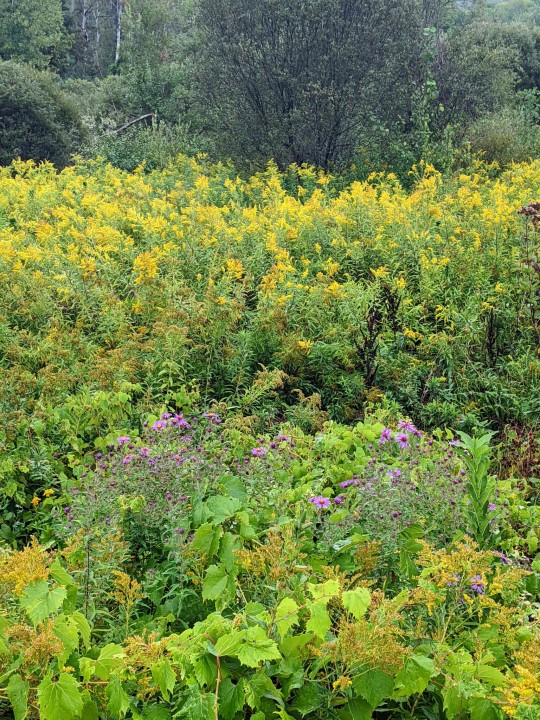
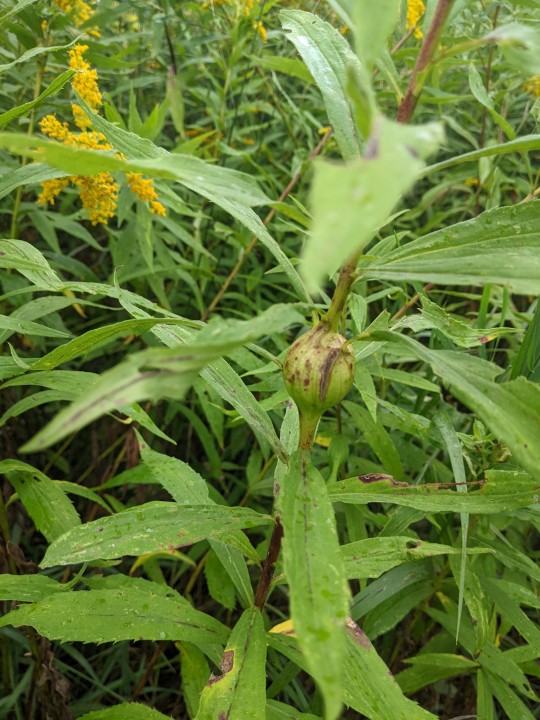

Field of goldenrod, pokeweed berries, jewelweed, evening primrose, more goldenrod with I think echinacea, a gall I found on goldenrod, and a plant I never identified.
I took these all in Western MA in early September. I'm terrible with Latin names and since I only do this casually I get by fine with common names. I really love identifying the plants around me it brings me a lot of joy.
--
Addition from the botanists here - picture 5 shows New England aster, Symphyotrichum novae-angliae, which is a New England native. I have bad news for you on the last one, though. That appears to be purple loosestrife, which, although pretty, is a highly invasive species often classified as a noxious weed.
47 notes
·
View notes
Text




Ceratina bee on some native Common Jewelweed in OR
2 notes
·
View notes
Text

Impatiens capensis / Common Jewelweed at the Sarah P. Duke Gardens at Duke University in Durham, NC
#Impatiens capensis#Impatiens#Common Jewelweed#Jewelweed#Touch me not#Native plants#Native flowers#Nature photography#photographers on tumblr#Sarah P. Duke Gardens#Duke Gardens#Duke University#Durham#Durham NC#North Carolina
11 notes
·
View notes
Text


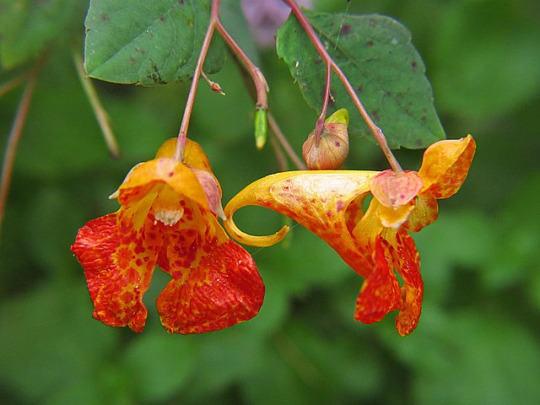
The Annotated Anne of Green Gables ~~ a special rereading
a little intro on how i will be doing things for this: generally I will not be commenting much on the story itself but more on the notes in the book i find most interesting and expanding/analyzing them :)
CHAPTER I ~~ Mrs. Rachel Lynde is Surprised + the epigraph
"The good stars met in your horoscope,/Made you of spirit and fire and dew." -Browning
This line is the first bit of text given by Montgomery, as seen in the epigraph. It comes from the poem "Evelyn Hope," by Robert Browning. This poem is about an old man lamenting the death of sixteen-year-old Evelyn and his love for her, which she never experienced. While the context makes this poem more morbid, the lines themselves are beautiful and lyrical. I am trying to figure out why Montgomery chose these lines to introduce Anne. Was it some deeper meaning she found in the poem? Was it the image of Evelyn that these lines describe? Did it match her image of Anne? Or something else entirely? Let me know what you think! (A watercolor of Evelyn from 1908 is above, and here is the poem)
"Mrs. Rachel Lynde lived just where the Avonlea main road dipped down into a little hollow, fringed with alders and ladies' eardrops and traversed by a brook that had its source away back in the woods of the old Cuthbert place; it was reputed to be an intricate, headlong brook in its earlier course through the woods, with dark secrets of pool and cascade."
The first line of the actual story (more like a complex sentence)! I just wanted to take a second to appreciate our scenery here and specifically talk about the "ladies' eardrops." When first reading, I knew this must be a plant, for it followed alders, but I knew nothing about it. The more common names include jewelweed and spotted touch-me-not. This plant is native to North America and is mostly found near creeks. It spreads very rapidly and does not need cross-pollination! Actually, in the State of Washington, it is considered a weed due to its fast reproduction. I think that including this plant with specifically that uncommon name for it is used to draw us into the almost fantastical world full of wonder that is Anne's soon-to-be home, Prince Edward Island. Because even if you do not know which plant the name refers to, the name shouts beauty and delicacy. I have even more thoughts about the symbolism of this plant but fear that I might be looking too much into something that might just be a passing reference. Oh and above is a photo of ladies' eardrops!
"Mrs. Rachel found abundant time to sit for hours at her kitchen window, knitting "cotton warp" quilts -- she had knitted sixteen of them, as Avonlea housekeepers were wont to tell in awed voices."
While Rachel Lynde must have 'abundant time,' she also must be extremely fast at knitting. "Cotton warp" refers to a kind of yarn used for weaving, and she was actually making a bedspread. With this type of yarn, knit squares were not a thing; instead, she would have used elaborate lacy patterns. After researching, I found a post in which a woman described how long her mother took to crochet a similar type of quilt. It took her mother approximately 300 to 400 hours to complete. And Rachel knit sixteen of them and is on her seventeenth at this point. No wonder the Avonlea housekeepers were in awe. But that is not the end of her quilts. She gives Anne six quilts while in college (five are just lent, though), Diana gets one for her wedding, and another two for Anne upon her own wedding (also not clear if any of these are newly knitted for the occasion or ones she already has). Also, our favorite person, Lucy Maud Montgomery, knit three of her own 'cotton warp' quilts in her lifetime. One of which is known as the 'Crazy Quilt,' and a photo is above!
This chapter didn't have too many notes that I found super interesting, for most of them had to do with geography, and it is a shorter chapter, so I hope you enjoyed my findings on these three topics!
next chapter
4 notes
·
View notes
Note
My current list of native plants that I should plant, I have no idea if these are already on the land
Which is why I need to survey it
And see if we have any other invasive plants, currently we have: the multi flora rose, the honeysuckle, and the stupid fucking mile-a-minute vine that I’m pulling tomorrow
I can’t remove the giant fields worth of multi flora roses or the giant honeysuckle bushes right now but I can get rid of that stupid fucking vine before it takes over the damn yard
Anyways here’s the list of surprisingly a lot of edible plants and wetland plants that are native and I should plant:
Rubus odoratus — flowering raspberry
Vitis riparia — river grape or Vitis labrusca — fox grape
Rubus recurvicaulis — arching blackberry
Viburnum opulus — highbush-cranberry
Aquilegia canadensis — red columbine
Impatiens capensis — jewelweed, spotted touch-me-not
Lobelia cardinalis — cardinal-flower, red lobelia
Comarum palustre — marsh-cinquefoil, purple marsh-locks
Ranunculus caricetorum — swamp buttercup, swamp crowfoot
Symphyotrichum ciliolatum — Lindley's American-aster
Adiantum pedatum — northern maidenhair fern
Thelypteris palustris — marsh fern
Woodsia glabella — smooth cliff fern
Dryopteris campyloptera — mountain wood fern
Calla palustris — water arum, wild calla
Erythronium americanum — American trout-lily
Lilium philadelphicum — wood lily
Cypripedium acaule — pink lady's-slipper
Juniperus communis — common juniper
Prunus serotina — black cherry
Rhododendron canadense — Canada rosebay, rhodora
Rhododendron groenlandicum — Labrador-tea
Ribes hirtellum — hairy-stemmed gooseberry
Morus rubra — red mulberry
Ribes triste — swamp red currant
Gaylussacia baccata — black huckleberry
Tilia americana — American linden
Vaccinium corymbosum — highbush blueberry
Sambucus nigra — black elderberry
Aralia nudicaulis — wild sarsaparilla
Matteuccia struthiopteris — fiddlehead fern, ostrich fern
Allium tricoccum — ramps, wild leek
Looks like you've got your work laid out for you, huh?
Try not to break your back and don't get burned in the sun.
5 notes
·
View notes
Note
If you’re up for it, top 5 favorite prairie plants and why? Or are there any parasitic prairie plants that you know of? Where I’m at we’ve got California Dodder and mistletoe but they’re the only ones I know about
OH THATS TOUGH.
5. Andropogon gerardii - Big Bluestem: basically THE prairie grass. you cannot have a tallgrass prairie without a tall grass lol.

4. Carex buxbaumii - Buxbaum's sedge: I can't in good conscience do this top 5 without including a sedge. all sedges are identifiable by their triangular stalks- "sedges have edges!" I'm still not fantastic at identifying specific species, but carex buxbaumii is one i'm pretty confident in, since i harvested them at my old internship! i couldn't find a great pic for it but their seed heads look like mint chocolate :3

3. Eryngium yuccifolium - Rattlesnake Master: aside from having the COOLEST FUCKING NAME POSSIBLY, this is also a really unique prairie plant! they don't have obvious "flowers," instead having a spiky green ball on a long stem (its still a flower though). despite their painful looking leaves, these guys aren't too bad to accidentally rub up against, especially if you've got bull thistle and common teasel in the same area (FUCK teasel).

2. Silphium perfoliatum - Cup Plant: really, I could go with any of the silphiums but cup plant is just such a cool plant. all silphiums get really tall and have beautiful big yellow flowers, but what makes cup plant special is its cups! where the leaves meet the (really cool, square) stem, they completely surround it and form a cup that actually holds water after it rains. theyre great for finding bugs since they have lots of nooks and crannies (and water)

1. Impatiens capensis - Jewelweed/Spotted Touch-me-not: not solely a prairie plant, but it's such a good one I gotta put it in here. it likes wetter environments when in full sun, which leads to it growing like ABSOLUTE CRAZY! they usually get to about 1-3' tall, but one that was at the end of a stream in full sun got to 6' at least. it's an impatiens so it spreads its seeds by fucken LAUNCHING them; very cool but also cmon i want to propagate you :( MOST importantly, though, it is a natural remedy for both poison ivy and stinging nettle. i'm not usually one for medicinal herbs but this plant has saved me lots of trouble (and money) by keeping those rashes down.

dodder my best friend dodder <3 i'm not sure if there are any other fully parasitic prairie plants, but wood betony is one i'm aware of that's hemiparasitic, getting some of its nutrients from other plants. i love parasitic plants, theyre so interesting...
#THANK YOU FOR ASK#this made me think long and hard.#honorable mentions include prairie blazing star and ohio spiderwort#as well as the other silphiums compass plant and prairie dock#ask me about my least favorite plants i know that top five by heart. no. 1 is teasel#FUCK TEASEL.#i say shit#ask
2 notes
·
View notes
Text
I'm reminded of a time I went on a hike with a friend. We must've been pretty freshly 16 (and her with a driver's license), because I don't remember anyone else being with us -- we were at this nature preserve that I had spent weeks doing a photography summer camp at for a few years in a row (and a survival camp, where I sliced a good bit of the flesh on my finger off... I only narrowly survived survival camp), and had been hiking at about as long as I can remember hiking. It's one of my favorite places, and she had never been there.
We took our cameras, and at some point I was crouched on the ground looking at something (jewelweed, maybe? It's common there, and I know I love its blooms and its practicality of fixing the damage done by nettles...) and she looked down at me from where she'd been staring at the treetops. We had that moment of 'you're seeing beauty where I wasn't looking'. I think about it every time I look at something little, and it reminds me to look at something big, too.
Original

236K notes
·
View notes
Text
Wk 16, 25th of June, 2024 Research
⭐️ How to enact a Celtic Wishing Tree?
From the text: Weighted Branches- Wishing Trees, Holy Wells, and Vibrant Matter by Maggie Slaughter...


Maggie Slaughter, St. Brendan's Holy Tree in Clonfert, Galway, 2021, photographic documentation of a site of a wish/wishing tree
From the text: The Fairy Forts and Fairy Trees of Ireland by Brehon Academy...
Farmers and landowners have long avoided disturbing these forts, as well as other ancient sites such as Neolithic tombs, stone circles, and standing stones, due to the belief that they are sacred and associated with fairy activity. Folklore has played a significant role in protecting these monuments and trees, including the sacred hawthorn trees which are believed to be associated with supernatural forces and bad luck if damaged or removed.
These trees that grew of their own accord, unplanted by human hands, were those most associated with faery activity. The hawthorn tree was particularly associated with the fairies and was regarded as a tree to be avoided, particularly at night.

Irish News, Hawthorn or Whitethorn Tree, 2021, photographic image
The Hawthorn Tree also has a number of positive superstitions associated with it, such as the belief that the tree could bestow healing or blessings on those who asked for its favour. As we will see below, the hawthorn ‘rag tree’ has long been revered among the Irish as a tree with healing properties. They will most often be found close to the healing holy wells that were first known and used by the druids. In modern times, the hawthorn tree has been known for its medicinal properties for centuries.

Unknown photographer, “Bread and Cheese,” a flowering hawthorn tree, photographic image
I am finding it startling how similar the flower buds look to the native Mānuka of Aotearoa, this flower shaper being common also to Japanese Quince and Cherry Blossom.

Melissa Barret, Marvellous Manuka, 2024, photographic image
From the text: Marvellous Mànuka by Melissa Barret...
The Mānuka bush is a common native New Zealand tree and a key ingredient with a long history of use in traditional Māori medicine, Rongoā.
Mānuka is most famous for the unique honey produced from its nectar which is renowned for its antibacterial and health properties. European settlers also used Mānuka leaves as a tea-like substitute, hence the common name 'Tea tree', however this name is also bestowed upon its relative the Australian native Melaleuca alternifolia, so the use of the Māori name is preferential.
From the text: The Language of Flowers by Camilla Grudova...
Most of my writing is set in interior, urban spaces, there aren’t many flowers or plants, which is something I am trying to challenge myself on in a new work. I like details, lists, in literature and want to avoid a Disney looking nature, a soft simple palette of a few greens. As a child, I could pluck absentmindlly at a bush, at a clustered area of weeds, knowing what I could eat (dandelions, wild carrot and strawberries, the tender inner part of long stalks of grass) or what I couldn’t; I knew what sting and stuck, generally name of this or that, but this slow build up of knowledge (adults ‘don’t run into the poison ivy!’ etc) has mostly vanished when I moved to a new continent. There aren’t, from what I remember, many nettles in Canada and I innocently strolled into clusters them in Scotland. I saw a friend here quickly pick some other plant (jewelweed) and apply it to a toddler who was screaming after touching a nettle. It got rid of the pain.
From the text: The Fairy Forts and Fairy Trees of Ireland by Brehon Academy...
Rag trees are often hawthorns that have been decorated with rags or cloths as part of a custom in Ireland and Scotland. The practice involves tying a rag to a branch of the tree while making a wish, usually for healing, good luck, or protection. The belief is that as the rag disintegrates, so too will the ailment or worry that it represents. Rag trees are seen as a way of connecting with the land and with the spirits of the natural world. The practice is also popular among those who follow Pagan or Celtic spiritual traditions, as well as among some members of the Irish Traveller community.

Maggie Slaughter, Wishing Tree Hill of Tara County Meath, 2021, photographic image
From the text: Double Take: The fairy trees dotted with rags, beads and dodies by The Journal...
Leave an object, make a wish.
HAWTHORN TREES ARE a relatively common sight around the country. But some are more distinctive than others. Two trees on the Hill of Tara in Meath, for example, are festooned with objects. Strips of fabric, beads, even a number of baby dodies. They’re known as fairy trees. So what is the connection to mythology? And why these trees in particular?
No matter the time of year, the fairy trees on the Hill of Tara will have the evidence of hundreds of prayers and wishes, tied to the tree blowing in the breeze. Each symbolising someone’s continuing faith in Celtic mythology that is thousands of years old.
Visitors leave items on the tree as they make a prayer or a wish. They might ask for healing, for the return of a loved one or animal – for something that they want to happen.
The folklore surrounding Ireland’s fairy trees is taken seriously. As well as being a place where visitors impart their wishes, another function of the fairy tree is to protect and encourage the well-being of the surrounding hedgerows.
From the text: foraging the fairy tree by Danny Dfi...
Hawthorn (genus Crataegus) is native across large parts of the Northern Hemisphere as over 100 different species. With flowering starting in May (and through to June) its many names include the May tree, May blossom, the Fairy Tree and in Welsh draenen wen (white thorn). Its flowering time means its associated with May Day festivities, and was used by witches to ward off evil spirits.
The young shoots and leaves are edible, and we've heard them referred to as 'bread and cheese', while the berries I have seen being given to children to eat in Portugal: they are high in vitamins B and C and have antioxidant properties. As a natural remedy, hawthorn is said to calm heart palpitations.
We don't recommend harvesting or digesting wild plants indiscriminately. The foragers code should always be followed, and an understanding of individual plant identification, properties and effects should always be well researched and understood (for example, in this case, raw haw berries have been reported to cause stomach upsets).

Jennifer Derig, Rags, Ribbons and other miscellaneous strings tied to a wishing tree, 2021, photographic documentation of a site of a wish/wishing tree
Natural wonders, the trees hold deep cultural significance, where locals and visitors alike come to make wishes, offer gifts to the fairies, and seek blessings.
From the text: Weighted Branches- Wishing Trees, Holy Wells, and Vibrant Matter by Maggie Slaughter...
Kinship, derived from the intersections between the tree, the human, and the holy, is renewed and potentially remade in the act of leaving behind a lasting assemblage. It is the Tree's junction with other things which transforms litter into interfacing vectors of divinity. It is in intersection with one another, the sacral cultures of devotional paraphernalia with the living trees and humans who organise them. How do these objects—diminutively called “prayers” by some—transform when they come into contact with one another on the surface of St. Brendan’s tree? In assenting to the ability of the horse-chestnut as an earthly offerings-box.
In terms of creating a wishing tree, I recently took six impressions of a pōhutukawa leaf (because they were looking so mystical to me, I couldn't really help myself). And thinking to the space, last year I noticed a pōhutukawa in the courtyard and borrowed white stones from around the base for a small stone circle outdoor work.
I think re-engaging with the tree is important, because looking at medical and healing elements of trees such as rowan, whitethorn or hawthorn and ash trees, trees that have the ability to heal in teas are significant in Celtic culture, the pōhutukawa flowers being made into a cordial does the same thing as the Celtic trees. By honouring this tree, I am engaging with Aotearoa directly again on the site. And I hope that me, Shaday and Ashleigh will be able tie on the ribbons and make our wishes to aliven the space.
In the past, I have connected with the base of trees by lay offerings for some kind of fairies (gem stones, painted rocks, notes) with my mum. These trees were the Australian Gum Trees growing on our rural property in Victoria, so they were also native trees. But I think by engaging with wishing and superstition it really links back to the welsh dewiniaeth (divination) and tree divination (dendromancy).
Overall, I think it relates really strongly to me trying to understand Tim Ingold's outline of Correspondences because it will be a direct correspondence with a piece of living flora (the tree branches) and therefore ground the indoor work with an inter-species action outside or adjacent to the gallery space.
Ashley Singer, a wishing tree, 2024, a collection of lace, silk and cotton ribbons tied to an outdoor pōhutukawa tree, variable media
A note: as the Celtic Trees are permanent, for the ethics of the tree and reducing litter in the city, the work will be deinstalled at the end of the exhibition.
0 notes